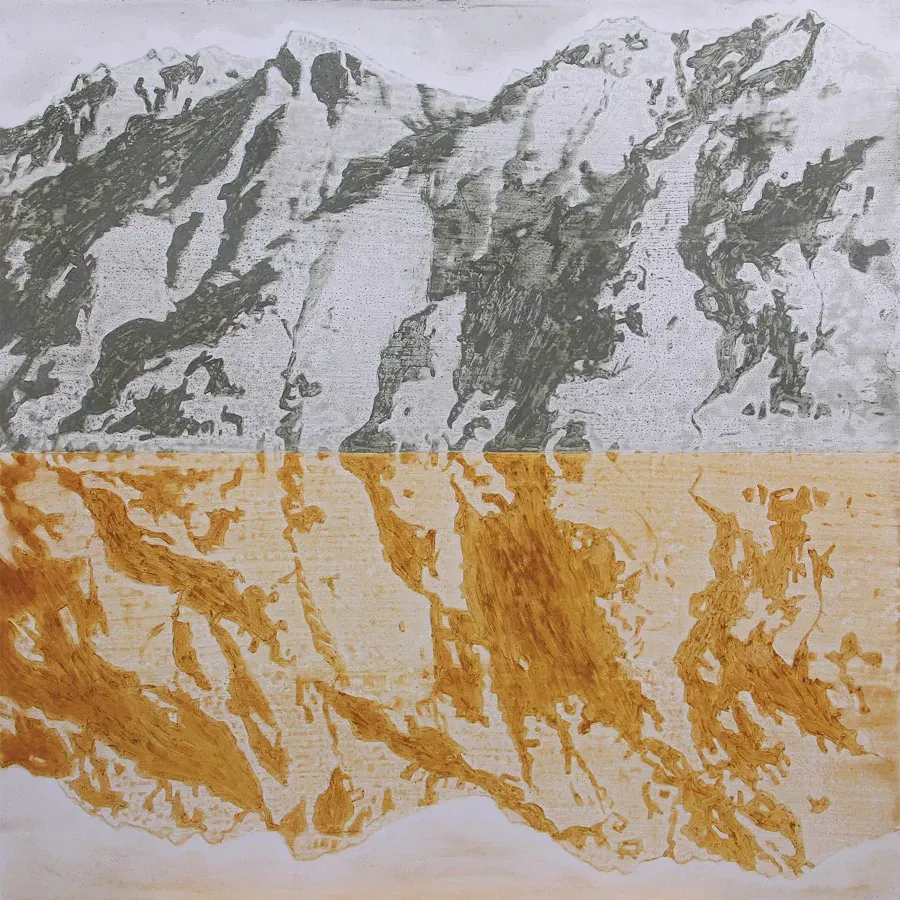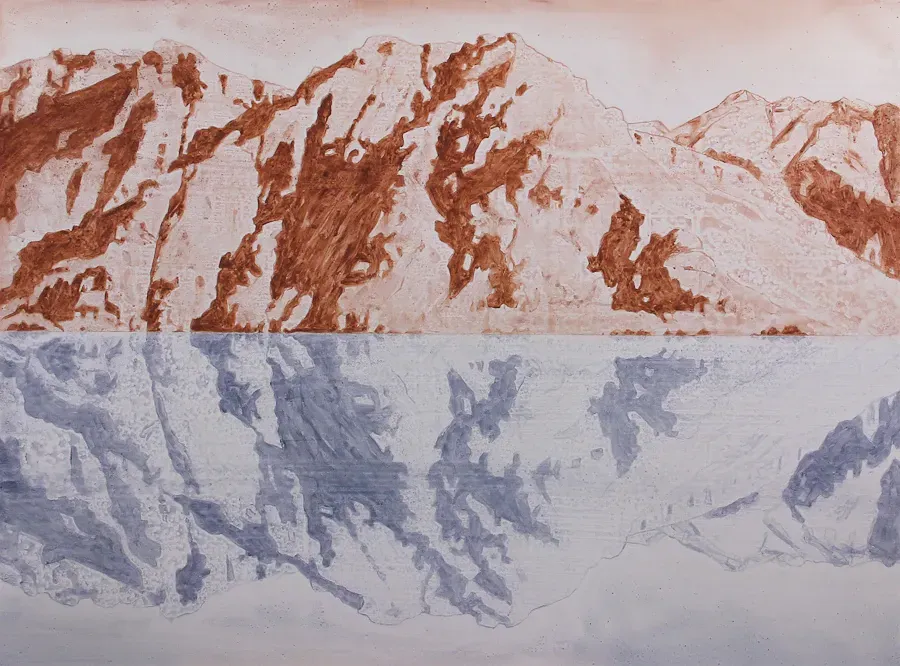I'll Be Your Mirror
Written by

An essay by Mark Amery republished on the occasion of a selection of The Southand Mud Paintings of Gary Freemantle being shown at Photospace Gallery Wellington 21 February - 15 March 2014.
“There is no such thing as a poor soil, just poor knowledge of its capabilities.” So runs the optimistic line on the Venture Southland website.
On this basis, Gary Freemantle might well be the South’s perfect artist visitor: a painter dedicated to exploring earth’s potential as a palette. 170 soil types have been mapped in the Southland region. The topoclimate soil map is a marbled riot of colour patches, riddled by rivulets of line. Reds, browns, yellows, purples and pinks in no fathomable order. Like some fiendishly difficult paint by numbers set, I’m reminded of the bare craggy hills in Freemantle’s new paintings.
Monochromatic surfaces here encourage the reading of patches of light and shadow as information. Shapes are to be interpreted and coloured in, as much as scenery is to be admired.
Venture Southland is a tourism and promotions agency. Making use of the earth is core Southern business. The business development section of their website is dominated by oil, gas and mineral extraction and agriculture. Beyond national park, over half of Southland is intensively farmed. The region’s self-image is part rolling farmland, part picturesque rugged landscapes.
Freemantle digs into the duality of this imagery a little deeper. Quite literally, you might say. The mirror lake is the iconic postcard image, providing a meditative, calm idyll. As the land shares its image with water, the postcard shares the traveller’s experience with friends and family - a human reproduction of a natural reproduction. We seem to find this comforting. But these mirror lake postcard-shaped paintings also provide for the viewer a mirror. And mirrors, let’s remember, are both troubling and comforting to look into.
When I read of “compaction, nutrient leaching, erosion, organic matter losses and waterlogging” as soil-related problems in Southland, the words resonate with what I see in Freemantle’s paintings. In contrast to the inkjet saturation of most imagery today, these landscapes look depleted: leached, compacted, waterlogged and eroded. They are both beautiful and disturbed.
A year’s worth of news headlines suggest the relationship between earth-based industry, environmental issues and the 100% Pure tourism brand are at the heart of the nation’s current conversation about how it sees itself. Freemantle might not intend political statement, but it’s inevitable when loaded national imagery is presented in all its muckiness. The truth is muddy and, like a mirror, it’s looking you in the face. The landscape looks numb, shorn back to the rub of things.
By virtue of Freemantle’s physical method he connects us to our psychological relationship with the land. The landscape becomes a body. In its creation through touch there is the impression of sex and violence. In ‘Carcass Lake’ the rupture of the mirrored shoreline, enfolding shapes and fleshy colour could remind you of the female labia, or the body’s muscular organs.
Even more revealing is another title: ‘Rorschach Lake’. The images resemble the famous psychological test where viewers are asked what they see in a mirrored ink blot. The idea is that, when shown a meaningless image, our minds will work hard to impose meaning. Here we are asked to read a landscape. As with the ink blot, it’s likely people will see the figurative. In some paintings you may see the profiles of heads. Like a mirror, we find ourselves in these landscapes created by another human hand.
When is a painting a sculpture? Using the material of a sculptor on canvas, Freemantle is also interested in this question. We can connect these paintings to last century’s craggy, hand-pinched sculptural clay forms, figures almost seeming to emerge from the earth. Giacometti or, closer to home, Greer Twiss comes to mind.
Freemantle’s practice has long had an interest in experimenting with its physical material. He began in the 1980s with thick, sticky sculptural licks of oil. By the late 1990s he was building up layers of encaustic onto the surface of his paintings to create raised designs and textures. More recently his interest in ceramics has seen him curate a touring survey exhibition of the work of Mirek Smisek. It’s surprising more painters don’t push their material like this, as sculptors do.
Freemantle’s practise was born in the 1980s amidst much painterly expressionistic activity. A graduate of ILAM in Canterbury, the school had become known for the German expressionist legacy left by teacher Rudi Gopas. Indeed Freemantle’s landscapes today sit in relationship to the work of two other ILAM trained painters, Neil Frazer and Euan McLeod. While Fraser too plays with the mirror image landscape, in McLeod’s work the human figure actually emerges as earth-clad giant from the land. Implicit in this expressionist tradition is that the self is emotionally and physically in the work – landscape and person become one. Freemantle’s work doesn’t subscribe to any particular school but it has this root.
Freemantle is the latest European artist in residence in Southland. William Hodges has been dubbed the first. Freemantle’s works here talk to the landscape tradition William Hodges helped found. Yet while Hodges’ landscapes were about colonial possession through framing the picturesque, Freemantle is asking how landscape painting might be made meaningful anew to those now well settled on the land.
Hodges was an itinerant artist, relishing the mobility of the Victorian age to travel through the Pacific, India and Europe. Freemantle too has been labelled an itinerant. That image has been formed by his preference of living in rural New Zealand, making regular drives into city centres. Whilst Hodges was a man of ocean, Freemantle is of the state highway. From early in his career Freemantle’s landscape has been the rural one. This is the real landscape for most New Zealanders, not Hodges’ peaks. Freemantle has presented it from the road, behind the fence, exploring new ways with paint and formats to convey our movement through it, and our disquieting yet warm and familial distance to it.
Travel has provided Freemantle his subjects. Now it provides his material. In his collection of earth samples from around the country, there is an echo of the collecting activity of those Victorian gentlemen who travelled the world in search of new scenes, species and varieties. In this way Freemantle reconnects painting with the study and exploration of the world. It’s just that now - like the fracking industry that has emerged in the last ten years – he finds the new and untapped places to be the land below our feet.
